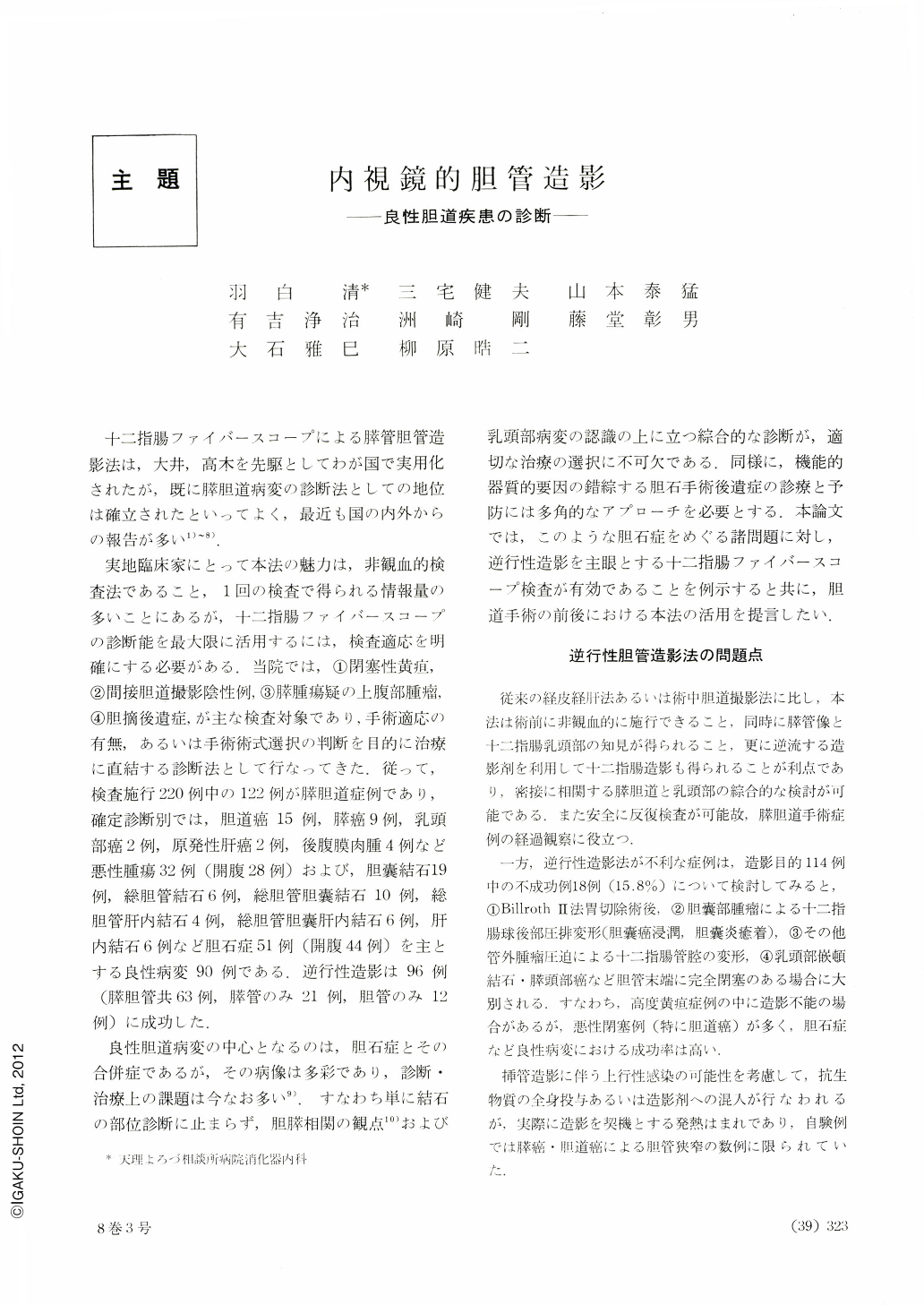Japanese
English
- 有料閲覧
- Abstract 文献概要
- 1ページ目 Look Inside
十二指腸ファイバースコープによる膵管胆管造影法は,大井,高木を先駆としてわが国で実用化されたが,既に膵胆道病変の診断法としての地位は確立されたといってよく,最近も国の内外からの報告が多い1)~8).
実地臨床家にとって本法の魅力は,非観血的検査法であること,1回の検査で得られる情報量の多いことにあるが,十二指腸ファイバースコープの診断能を最大限に活用するには,検査適応を明確にする必要がある.当院では,①閉塞性黄疸,②間接胆道撮影陰性例,③膵腫瘍疑の上腹部腫瘤,④胆摘後遺症,が主な検査対象であり,手術適応の有無,あるいは手術術式選択の判断を目的に治療に直結する診断法として行なってきた.従って,検査施行220例中の122例が膵胆道症例であり,確定診断別では,胆道癌15例,膵癌9例,乳頭部癌2例,原発性肝癌2例,後腹膜肉腫4例など悪性腫瘍32例(開腹28例)および,胆囊結石19例,総胆管結石6例,総胆管胆囊結石10例,総胆管肝内結石4例,総胆管胆囊肝内結石6例,肝内結石6例など胆石症51例(開腹44例)を主とする良性病変90例である.逆行性造影は96例(膵胆管共63例,膵管のみ21例,胆管のみ12例)に成功した.
Development of fiberoptic duodenoscopy has not only permitted easy access to the papilla of Vater but also a broader approach to the biliary-pancreatic complex which works as a unit in normal and diseased conditions. The instrument which allows thorough inspection and direct-vision biopsy of the duodenum as well as retrograde pancreatocholangiography and aspiration cytology of bile and pancreatic juice by cannulation of the papilla makes a definite contribution toward more accurate diagnosis of obstructive jaundice and pancreatic disease which has continued to be a challenging problem.
During the period of January 1971 through October 1972, 220 duodenoscopic examinations were performed at the Tenri Hospital. Selected indications, partly interrelated, are: (1) obstructive jaundice, (2) non-visualization of biliary tract by intravenous cholangiography, (3) undiagnosed upper abdominal mass, (4) postbiliary surgery syndrome. Direct-vision biopsy was performed in 31 patients, and retrograde pancreatocholangiography was successful in 96.
Final diagnoses of 122 patients with biliary-pancreatic diseases confirmed by laparotomy (76), autopsy (7) and other diagnostic means include bilary-tract carcinoma (15), pancreatic carcinoma (9), carcinoma of the papilla of Vater (2), cholelithiasis (51), chronic pancreatitis (9) and intrahepatic cholestasis (9). Correct diagnoses were reached in 40 out of 51 patients with obstructive jaundice.
With retrograde cholangiography salient features of technique, interpretation, limitation and relative merits compared to percutaneous transhepatic cholangiography were illustrated with representative cases of cholelithiasis and postcholecystectomy syndrome. Usefulness of combined examinations of endoscopy and radiography was demonstrated in specific lesions such as impacted ampullary stones, intrahepatic stones, residual or recurrent stones, postoperative stricture of common duct, stenosing papillitis, sphincteric incompetency and internal biliary fistulas.
Duodenoscopy with retrograde pancreatocholangiography is now an established clinical technique which is an indispensable aid to preoperative diagnosis of cholelithiasis and its complications, and should further contribute to reduction of morbidity from biliary-tract surgery.

Copyright © 1973, Igaku-Shoin Ltd. All rights reserved.


